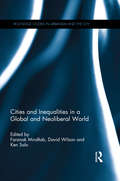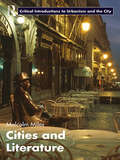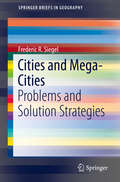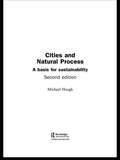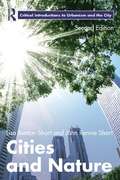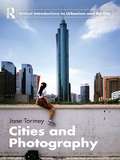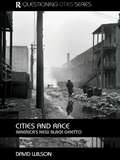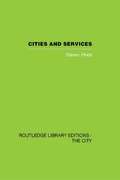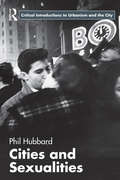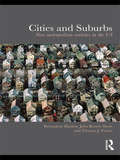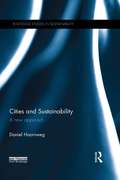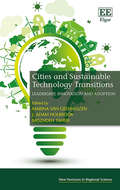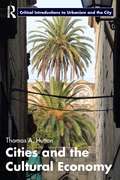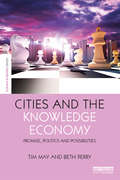- Table View
- List View
Cities and Inequalities in a Global and Neoliberal World (Routledge Studies in Urbanism and the City)
by David Wilson Faranak Miraftab Ken E. SaloCities continue to be key sites for the production and contestation of inequalities generated by an ongoing but troubled neoliberal project. Neoliberalism’s onslaught across the globe now shapes diverse inequalities -- poverty, segregation, racism, social exclusion, homelessness -- as city inhabitants feel the brunt of privatization, state re-organization, and punishing social policy. This book examines the relationship between persistent neoliberalism and the production and contestation of inequalities in cities across the world. Case studies of current city realities reveal a richly place-specific and generalizable neoliberal condition that further deepens the economic, social, and political relations that give rise to diverse inequalities. Diverse cases also show how people struggle against a neoliberal ethos and hence the open-endedness of futures in these cities.
Cities and Literature (Routledge Critical Introductions to Urbanism and the City)
by Malcolm MilesThis book offers a critical introduction to the relation between cities and literature (fiction, poetry and literary criticism) from the late eighteenth to twenty-first centuries. It examines examples of writing from Europe, North America and post-colonial countries, juxtaposed with key ideas from urban cultural and critical theories. Cities and Literature shows how literature frames real and imagined constructs and experiences of cities. Arranged thematically each chapter offers a narrative which introduces a number of key thinkers and writers whose vision illuminates the prevailing idea of the city at the time. The themes are extended or challenged by boxed cases of specific texts or images accompanied by short critical commentaries; the structure provides readers with a map of the terrain enabling connections across time and place within manageable limits, and offers elements of critical discussion to serve a growing number of university courses which involve the intersections of cities and literature. This volume offers access to literature from an urban perspective for the social sciences, and access to urbanism from a literary viewpoint. It is an excellent resource for both undergraduate and postgraduate students in the fields of urban studies and English literature, planning, cultural and human geographies, architecture, cultural studies and cultural policy.
Cities and Literature (Routledge Critical Introductions to Urbanism and the City)
by Malcolm MilesThis book offers a critical introduction to the relation between cities and literature (fiction, poetry and literary criticism) from the late eighteenth to twenty-first centuries. It examines examples of writing from Europe, North America and post-colonial countries, juxtaposed with key ideas from urban cultural and critical theories. Cities and Literature shows how literature frames real and imagined constructs and experiences of cities. Arranged thematically each chapter offers a narrative which introduces a number of key thinkers and writers whose vision illuminates the prevailing idea of the city at the time. The themes are extended or challenged by boxed cases of specific texts or images accompanied by short critical commentaries; the structure provides readers with a map of the terrain enabling connections across time and place within manageable limits, and offers elements of critical discussion to serve a growing number of university courses which involve the intersections of cities and literature. This volume offers access to literature from an urban perspective for the social sciences, and access to urbanism from a literary viewpoint. It is an excellent resource for both undergraduate and postgraduate students in the fields of urban studies and English literature, planning, cultural and human geographies, architecture, cultural studies and cultural policy.
Cities and Mega-Cities: Problems and Solution Strategies (SpringerBriefs in Geography)
by Frederic R. SiegelThis book discusses existing and future global problems of physical, chemical, biological and societal origins faced by increasingly populated cities and mega-cities, and options to mitigate or eliminate them. In nine chapters, the book focuses on rehabilitation and redevelopment projects aimed at converting shantytowns/slums into well serviced neighborhoods via secure housing, clean piped water, adequate access to sanitation, and other amenities for good living conditions. Examples of rehabilitation (restore capacity, structures, efficiency) and redevelopment (redesign, rebuild, attract investment) are addressed in detail, as are the sources of major financing to support such projects and proposals. The final chapters also discuss problems faced by countries with contracting populations, and their viable solutions. The book will be of interest to academics, city planners, land-use planners, NGOs, and designers /architects specializing in urban development and redevelopment.
Cities and Natural Process
by Michael HoughCities and Natural Process is a book for all concerned with the future of our cities, their design and sustainability, and our quality of life within them. Michael Hough describes how economic and technological values have squeezed any real sense of nature out of the modern city, the ways in which this has led to a divisive separation of countryside and city, wasted much of the city's resources, and shaped an urban aesthetic which is sharply at odds with both natural and social processes. Against this is set an alternative history of ecological values informing proven approaches to urban design which work with nature in the city.
Cities and Natural Process
by Michael HoughCities and Natural Process is a book for all concerned with the future of our cities, their design and sustainability, and our quality of life within them. Michael Hough describes how economic and technological values have squeezed any real sense of nature out of the modern city, the ways in which this has led to a divisive separation of countryside and city, wasted much of the city's resources, and shaped an urban aesthetic which is sharply at odds with both natural and social processes. Against this is set an alternative history of ecological values informing proven approaches to urban design which work with nature in the city.
Cities and Nature (Routledge Critical Introductions to Urbanism and the City)
by Lisa Benton-Short John Rennie ShortCities and Nature connects environmental processes with social and political actions. The book reconnects science and social science to demonstrate how the city is part of the environment and how it is subject to environmental constraints and opportunities. This second edition has been extensively revised and updated with in-depth examination of theory and critical themes. Greater discussion is given to urbanization trends and megacities; the post-industrial city and global economic changes; developing cities and slums; urban political ecology; the role of the city in climate change; and sustainability. The book explores the historical relationship between cities and nature, contemporary challenges to this relationship, and attempts taken to create more sustainable cities. The historical context situates urban development and its impact on the environment, and in turn the environmental impact on people in cities. This provides a foundation from which to understand contemporary issues, such as urban political ecology, hazards and disasters, water quality and supply, air pollution and climate change. The book then considers sustainability and how it has been informed by different theoretical approaches. Issues of environmental justice and the role of gender and race are explored. The final chapter examines the ways in which cities are practicing sustainability, from light "greening" efforts such as planting trees, to more comprehensive sustainability plans that integrate the multiple dimensions of sustainability. The text contains case studies from around the globe, with many drawn from cities in the developing world, as well as reviews of recent research, updated and expanded further reading to highlight relevant films, websites and journal articles. This book is an asset to students and researchers in geography, environmental studies, urban studies and planning and sustainability.
Cities and Nature (Routledge Critical Introductions to Urbanism and the City)
by Lisa Benton-Short John Rennie ShortCities and Nature connects environmental processes with social and political actions. The book reconnects science and social science to demonstrate how the city is part of the environment and how it is subject to environmental constraints and opportunities. This second edition has been extensively revised and updated with in-depth examination of theory and critical themes. Greater discussion is given to urbanization trends and megacities; the post-industrial city and global economic changes; developing cities and slums; urban political ecology; the role of the city in climate change; and sustainability. The book explores the historical relationship between cities and nature, contemporary challenges to this relationship, and attempts taken to create more sustainable cities. The historical context situates urban development and its impact on the environment, and in turn the environmental impact on people in cities. This provides a foundation from which to understand contemporary issues, such as urban political ecology, hazards and disasters, water quality and supply, air pollution and climate change. The book then considers sustainability and how it has been informed by different theoretical approaches. Issues of environmental justice and the role of gender and race are explored. The final chapter examines the ways in which cities are practicing sustainability, from light "greening" efforts such as planting trees, to more comprehensive sustainability plans that integrate the multiple dimensions of sustainability. The text contains case studies from around the globe, with many drawn from cities in the developing world, as well as reviews of recent research, updated and expanded further reading to highlight relevant films, websites and journal articles. This book is an asset to students and researchers in geography, environmental studies, urban studies and planning and sustainability.
Cities and Photography
by Jane TormeyPhotographs display attitudes, agency and vision in the way cities are documented and imagined. Cities and Photography explores the relationship between people and the city, visualized in photographs. It provides a visually focused examination of the city and urbanism for a range of different disciplines: across the social sciences and humanities, photography and fine art. This text offers different perspectives from which to view social, political and cultural ideas about the city and urbanism, through both verbal discussion and photographic representation. It provides introductions to theoretical conceptions of the city that are useful to photographers addressing urban issues, as well as discussing themes that have preoccupied photographers and informed cultural issues central to a discussion of city. This text interprets the city as a spatial network that we inhabit on different conceptual, psychological and physical levels, and gives emphasis to how people operate within, relate to, and activate the city via construction, habitation and disruption. Cities and Photography aims to demonstrate the potential of photography as a contributor to commentary and analytical frameworks: what does photography as a medium provide for a vision of ‘city’ and what can photographs tell us about cities, histories, attitudes and ideas? This introductory text is richly illustrated with case studies and over 50 photographs, summarizing complex theory and analysis with application to specific examples. Emphasis is given to international, contemporary photographic projects to provide provide focus for the discussion of theoretical conceptions of the city through the analysis of photographic interpretation and commentary. This text will be of great appeal to those interested in Photography, Urban Studies and Human Geography.
Cities and Photography
by Jane TormeyPhotographs display attitudes, agency and vision in the way cities are documented and imagined. Cities and Photography explores the relationship between people and the city, visualized in photographs. It provides a visually focused examination of the city and urbanism for a range of different disciplines: across the social sciences and humanities, photography and fine art. This text offers different perspectives from which to view social, political and cultural ideas about the city and urbanism, through both verbal discussion and photographic representation. It provides introductions to theoretical conceptions of the city that are useful to photographers addressing urban issues, as well as discussing themes that have preoccupied photographers and informed cultural issues central to a discussion of city. This text interprets the city as a spatial network that we inhabit on different conceptual, psychological and physical levels, and gives emphasis to how people operate within, relate to, and activate the city via construction, habitation and disruption. Cities and Photography aims to demonstrate the potential of photography as a contributor to commentary and analytical frameworks: what does photography as a medium provide for a vision of ‘city’ and what can photographs tell us about cities, histories, attitudes and ideas? This introductory text is richly illustrated with case studies and over 50 photographs, summarizing complex theory and analysis with application to specific examples. Emphasis is given to international, contemporary photographic projects to provide provide focus for the discussion of theoretical conceptions of the city through the analysis of photographic interpretation and commentary. This text will be of great appeal to those interested in Photography, Urban Studies and Human Geography.
Cities and Race: America's New Black Ghetto (Questioning Cities)
by David WilsonThis fascinating book examines the 1990s rise of a new black ghetto in rust belt America, 'the global ghetto'. It uses the emergent perspective of 'racial economy' to delineate a fundamental proposition; historically neglected and marginalized black ghettos, in a 1990s era of societal boom and bust, have become more impoverished, more stigmatized, and functionally ambiguous as areas. As these ghettos grow in size and become more stigmatized entities in contemporary society, our understanding of them in relation to evolving cities and society has not kept pace. This book looks to the heart of this misunderstanding, to find out how race and political economy in cities dynamically connect in new ways ('racial economy') to deepen deprivation in these areas. This book is an essential read for students of geography, urban studies and sociology.
Cities and Race: America's New Black Ghetto (Questioning Cities)
by David WilsonThis fascinating book examines the 1990s rise of a new black ghetto in rust belt America, 'the global ghetto'. It uses the emergent perspective of 'racial economy' to delineate a fundamental proposition; historically neglected and marginalized black ghettos, in a 1990s era of societal boom and bust, have become more impoverished, more stigmatized, and functionally ambiguous as areas. As these ghettos grow in size and become more stigmatized entities in contemporary society, our understanding of them in relation to evolving cities and society has not kept pace. This book looks to the heart of this misunderstanding, to find out how race and political economy in cities dynamically connect in new ways ('racial economy') to deepen deprivation in these areas. This book is an essential read for students of geography, urban studies and sociology.
Cities and Services: The geography of collective consumption
by Steven PinchCaught between the twin pressures of rising public expectations and falling resources, public services have become the subject of intense academic scrutiny and public debate. Much of this controversy has been fuelled by a growing realisation that where people live has an important influence upon their access to services. The so-called 'postcode lottery.' The first part of this book considers what is meant by the term 'collective consumption' and discusses the main differences between the British and American loyal government systems. It examines various geographical schools of analysis which focus on jurisdictional partitioning, locational efficiency, externalities and locational conflict. Subsequent chapters explore the relevance of public choice, neo-Weberian and neo-Marxist theories for an understanding of collective consumption. The final section looks at ways in which spatial perspectives can be linked with broader theoretical approaches in the context of modern developments. This book was first published in it's current form in 1985.
Cities and Services: The geography of collective consumption
by Steven PinchCaught between the twin pressures of rising public expectations and falling resources, public services have become the subject of intense academic scrutiny and public debate. Much of this controversy has been fuelled by a growing realisation that where people live has an important influence upon their access to services. The so-called 'postcode lottery.' The first part of this book considers what is meant by the term 'collective consumption' and discusses the main differences between the British and American loyal government systems. It examines various geographical schools of analysis which focus on jurisdictional partitioning, locational efficiency, externalities and locational conflict. Subsequent chapters explore the relevance of public choice, neo-Weberian and neo-Marxist theories for an understanding of collective consumption. The final section looks at ways in which spatial perspectives can be linked with broader theoretical approaches in the context of modern developments. This book was first published in it's current form in 1985.
Cities and Sexualities (Routledge Critical Introductions to Urbanism and the City)
by Phil HubbardFrom the hotspots of commercial sex through to the suburbia of twitching curtains, urban life and sexualities appear inseparable. Cities are the source of our most familiar images of sexual practice, and are the spaces where new understandings of sexuality take shape. In an era of global business and tourism, cities are also the hubs around which a global sex trade is organised and where virtual sex content is obsessively produced and consumed. Detailing the relationships between sexed bodies, sexual subjectivities and forms of intimacy, Cities and Sexualities explores the role of the city in shaping our sexual lives. At the same time, it describes how the actions of urban governors, city planners, the police and judiciary combine to produce cities in which some sexual proclivities and tastes are normalised and others excluded. In so doing, it maps out the diverse sexual landscapes of the city - from spaces of courtship, coupling and cohabitation through to sites of adult entertainment, prostitution, and pornography. Considering both the normative geographies of heterosexuality and monogamy, as well as urban geographies of radical/queer sex, this book provides a unique perspective on the relationship between sex and the city. Cities and Sexualities offers a wide overview of the state-of-the-art in geographies and sociologies of sexuality, as well as an empirically-grounded account of the forms of desire that animate the erotic city. It describes the diverse sexual landscapes that characterise both the contemporary Western city as well as cities in the global South. The book features a wide range of boxed case studies as well as suggestions for further reading at the end each chapter. It will appeal to undergraduate students studying Geography, Urban Studies, Gender Studies and Sociology.
Cities and Sexualities (Routledge Critical Introductions to Urbanism and the City)
by Phil HubbardFrom the hotspots of commercial sex through to the suburbia of twitching curtains, urban life and sexualities appear inseparable. Cities are the source of our most familiar images of sexual practice, and are the spaces where new understandings of sexuality take shape. In an era of global business and tourism, cities are also the hubs around which a global sex trade is organised and where virtual sex content is obsessively produced and consumed. Detailing the relationships between sexed bodies, sexual subjectivities and forms of intimacy, Cities and Sexualities explores the role of the city in shaping our sexual lives. At the same time, it describes how the actions of urban governors, city planners, the police and judiciary combine to produce cities in which some sexual proclivities and tastes are normalised and others excluded. In so doing, it maps out the diverse sexual landscapes of the city - from spaces of courtship, coupling and cohabitation through to sites of adult entertainment, prostitution, and pornography. Considering both the normative geographies of heterosexuality and monogamy, as well as urban geographies of radical/queer sex, this book provides a unique perspective on the relationship between sex and the city. Cities and Sexualities offers a wide overview of the state-of-the-art in geographies and sociologies of sexuality, as well as an empirically-grounded account of the forms of desire that animate the erotic city. It describes the diverse sexual landscapes that characterise both the contemporary Western city as well as cities in the global South. The book features a wide range of boxed case studies as well as suggestions for further reading at the end each chapter. It will appeal to undergraduate students studying Geography, Urban Studies, Gender Studies and Sociology.
Cities and Suburbs: New Metropolitan Realities in the US
by Bernadette Hanlon John Rennie Short Thomas J. VicinoThis book is a systematic examination of the historical and current roles that cities and suburbs play in US metropolitan areas. It explores the history of cities and suburbs, their changing dynamics with each other, their growing diversity, the environmental consequences of their development and finally the extent and nature of their decline and renewal. Cities and Suburbs: New Metropolitan Realities in the US offers a comprehensive examination of demographic and socioeconomic processes of US suburbanization by providing a succinct guide to understanding the dynamic relationship between metropolitan structure and processes of social change. A variety of case studies are used in the chapters to explore suburban successes and failures and the discourse concludes with reflections on metropolitan policy and planning for the twenty-first century. The topics of discussion include: Key ideas and concepts on the demographic and sociospatial aspects of metropolitan change The changing nature of city and suburban population migration and their relationships with changes at the local, metropolitan, national, and global levels Current metropolitan public policy issues of large cities and suburbs Links of suburbanization to metropolitan transformation and the growing dichotomy between suburban decline and suburban sprawl in metropolitan areas. Cities and Suburbs relies on theorized case studies, demographic analysis, maps, and photos from North America. Written in a clear and accessible style, the book addresses various fundamental questions about the socioeconomic role that suburbs and cities play in shaping metropolitan areas, their environmental impact, the political consequences, and the resulting policy debates. This is essential reading for scholars and students of Geography, Economics, Politics, Sociology, Urban Studies and Urban Planning.
Cities and Suburbs: New Metropolitan Realities in the US
by Bernadette Hanlon John Rennie Short Thomas J. VicinoThis book is a systematic examination of the historical and current roles that cities and suburbs play in US metropolitan areas. It explores the history of cities and suburbs, their changing dynamics with each other, their growing diversity, the environmental consequences of their development and finally the extent and nature of their decline and renewal. Cities and Suburbs: New Metropolitan Realities in the US offers a comprehensive examination of demographic and socioeconomic processes of US suburbanization by providing a succinct guide to understanding the dynamic relationship between metropolitan structure and processes of social change. A variety of case studies are used in the chapters to explore suburban successes and failures and the discourse concludes with reflections on metropolitan policy and planning for the twenty-first century. The topics of discussion include: Key ideas and concepts on the demographic and sociospatial aspects of metropolitan change The changing nature of city and suburban population migration and their relationships with changes at the local, metropolitan, national, and global levels Current metropolitan public policy issues of large cities and suburbs Links of suburbanization to metropolitan transformation and the growing dichotomy between suburban decline and suburban sprawl in metropolitan areas. Cities and Suburbs relies on theorized case studies, demographic analysis, maps, and photos from North America. Written in a clear and accessible style, the book addresses various fundamental questions about the socioeconomic role that suburbs and cities play in shaping metropolitan areas, their environmental impact, the political consequences, and the resulting policy debates. This is essential reading for scholars and students of Geography, Economics, Politics, Sociology, Urban Studies and Urban Planning.
Cities and Sustainability: A new approach (Routledge Studies in Sustainability)
by Daniel HoornwegCities are the most likely actors to design and bring about lasting sustainability. An agreement among the world’s larger cities is possible, and likely a necessary but insufficient condition to achieve sustainable development. Cities and Sustainability explores the ways in which cities are both the biggest threat to sustainability, and the most powerful tool to get us to sustainable development. Employing an innovative methodology to a complex issue, the book proposes new metrics and approaches that assume cities as fundamental in the search for sustainability. Providing population projections for the world’s larger cities and a hierarchy of sustainable cities, the author develops two new tools: (i) a cities approach to physical and socio-economic boundaries, and (ii) sustainability costs curves. These tools are designed to be implemented in a multi-stakeholder, integrated partnership that truly maximizes the benefits of cities in the quest for sustainability. Applying the tools outlined in the book to case studies from Dakar, Mumbai, Sao Paulo, Shanghai and Toronto, this volume will be of great relevance to students, scholars and practitioners with an interest in urban and city management, climate change, and environment and sustainability more broadly.
Cities and Sustainability: A new approach (Routledge Studies in Sustainability)
by Daniel HoornwegCities are the most likely actors to design and bring about lasting sustainability. An agreement among the world’s larger cities is possible, and likely a necessary but insufficient condition to achieve sustainable development. Cities and Sustainability explores the ways in which cities are both the biggest threat to sustainability, and the most powerful tool to get us to sustainable development. Employing an innovative methodology to a complex issue, the book proposes new metrics and approaches that assume cities as fundamental in the search for sustainability. Providing population projections for the world’s larger cities and a hierarchy of sustainable cities, the author develops two new tools: (i) a cities approach to physical and socio-economic boundaries, and (ii) sustainability costs curves. These tools are designed to be implemented in a multi-stakeholder, integrated partnership that truly maximizes the benefits of cities in the quest for sustainability. Applying the tools outlined in the book to case studies from Dakar, Mumbai, Sao Paulo, Shanghai and Toronto, this volume will be of great relevance to students, scholars and practitioners with an interest in urban and city management, climate change, and environment and sustainability more broadly.
Cities and Sustainable Technology Transitions: Leadership, Innovation and Adoption (New Horizons in Regional Science series)
by Marina Van Geenhuizen J. Adam Holbrook Mozhdeh TaheriCities are undoubted key players in technology creation and adoption for sustainable transitions. This book addresses both the active and passive roles of cities in technology innovation, commercialisation, mass-production and adoption. In particular, it examines elements of three socio-technical systems, energy, transport and healthcare. The authors investigate cities in Europe, Asia and North America, providing an in depth understanding of the differences in leadership roles that cities adopt across the globe. The book breaks new ground in the analysis of topical issues such as local ‘cradle’ conditions, incentive schemes, niche-development, living labs, impact bonds, grass-roots intermediation and adaptive policy making. Researchers and students involved in the urban studies, socio-technical transitions and sustainability would greatly benefit from reading this book. The variety of practical examples also makes this book an important tool for city policy makers, as well as public policy and public sector scholars.
Cities and the Cultural Economy (Routledge Critical Introductions to Urbanism and the City)
by Thomas A. HuttonThe cultural economy forms a leading trajectory of urban development, and has emerged as a key facet of globalizing cities. Cultural industries include new media, digital arts, music and film, and the design industries and professions, as well as allied consumption and spectacle in the city. The cultural economy now represents the third-largest sector in many metropolitan cities of the West including London, Berlin, New York, San Francisco, and Melbourne, and is increasingly influential in the development of East Asian cities (Tokyo, Shanghai, Hong Kong and Singapore), as well as the mega-cities of the Global South (e.g. Mumbai, Capetown, and São Paulo). Cities and the Cultural Economy provides a critical integration of the burgeoning research and policy literatures in one of the most prominent sub-fields of contemporary urban studies. Policies for cultural economy are increasingly evident within planning, development and place-marketing programs, requiring large resource commitments, but producing – on the evidence – highly uneven results. Accordingly the volume includes a critical review of how the new cultural economy is reshaping urban labour, housing and property markets, contributing to gentrification and to ‘precarious employment’ formation, as well as to broadly favorable outcomes, such as community regeneration and urban vitality. The volume acknowledges the important growth dynamics and sustainability of key creative industries. Written primarily as a text for upper-level undergraduate and Masters students in urban, economic and social geography; sociology; cultural studies; and planning, this provocative and compelling text will also be of interest to those studying urban land economics, architecture, landscape architecture and the built environment.
Cities and the Cultural Economy (Routledge Critical Introductions to Urbanism and the City)
by Thomas A. HuttonThe cultural economy forms a leading trajectory of urban development, and has emerged as a key facet of globalizing cities. Cultural industries include new media, digital arts, music and film, and the design industries and professions, as well as allied consumption and spectacle in the city. The cultural economy now represents the third-largest sector in many metropolitan cities of the West including London, Berlin, New York, San Francisco, and Melbourne, and is increasingly influential in the development of East Asian cities (Tokyo, Shanghai, Hong Kong and Singapore), as well as the mega-cities of the Global South (e.g. Mumbai, Capetown, and São Paulo). Cities and the Cultural Economy provides a critical integration of the burgeoning research and policy literatures in one of the most prominent sub-fields of contemporary urban studies. Policies for cultural economy are increasingly evident within planning, development and place-marketing programs, requiring large resource commitments, but producing – on the evidence – highly uneven results. Accordingly the volume includes a critical review of how the new cultural economy is reshaping urban labour, housing and property markets, contributing to gentrification and to ‘precarious employment’ formation, as well as to broadly favorable outcomes, such as community regeneration and urban vitality. The volume acknowledges the important growth dynamics and sustainability of key creative industries. Written primarily as a text for upper-level undergraduate and Masters students in urban, economic and social geography; sociology; cultural studies; and planning, this provocative and compelling text will also be of interest to those studying urban land economics, architecture, landscape architecture and the built environment.
Cities and the Knowledge Economy: Promise, Politics and Possibilities (The Earthscan Science in Society Series)
by Tim May Beth PerryCities and the Knowledge Economy is an in-depth, interdisciplinary, international and comparative examination of the relationship between knowledge and urban development in the contemporary era. Through the lenses of promise, politics and possibility, it examines how the knowledge economy has arisen, how different cities have sought to realise its potential, how universities play a role in its realisation and, overall, what this reveals about the relationship between politics, capitalism, space, place and knowledge in cities. The book argues that the 21st century city has been predicated on particular circuits of knowledge that constitute expertise as residing in elite and professional epistemic communities. In contrast, alternative conceptions of the knowledge society are founded on assumptions which take analysis, deliberation, democracy and the role of the citizen and communities of practice seriously. Drawing on a range of examples from cities around the world, the book reflects on these possibilities and asks what roles the practice of ‘active intermediation’, the university and a critical and engaged social scientific practice can all play in this process. The book is aimed at researchers and students from different disciplines – geography, politics, sociology, business studies, economics and planning – with interests in contemporary urbanism and the role of knowledge in understanding development, as well as urban policymakers, politicians and practitioners who are concerned with the future of our cities and seek to create coalitions of different communities oriented towards more just and sustainable futures.
Cities and the Knowledge Economy: Promise, Politics and Possibilities (The Earthscan Science in Society Series)
by Tim May Beth PerryCities and the Knowledge Economy is an in-depth, interdisciplinary, international and comparative examination of the relationship between knowledge and urban development in the contemporary era. Through the lenses of promise, politics and possibility, it examines how the knowledge economy has arisen, how different cities have sought to realise its potential, how universities play a role in its realisation and, overall, what this reveals about the relationship between politics, capitalism, space, place and knowledge in cities. The book argues that the 21st century city has been predicated on particular circuits of knowledge that constitute expertise as residing in elite and professional epistemic communities. In contrast, alternative conceptions of the knowledge society are founded on assumptions which take analysis, deliberation, democracy and the role of the citizen and communities of practice seriously. Drawing on a range of examples from cities around the world, the book reflects on these possibilities and asks what roles the practice of ‘active intermediation’, the university and a critical and engaged social scientific practice can all play in this process. The book is aimed at researchers and students from different disciplines – geography, politics, sociology, business studies, economics and planning – with interests in contemporary urbanism and the role of knowledge in understanding development, as well as urban policymakers, politicians and practitioners who are concerned with the future of our cities and seek to create coalitions of different communities oriented towards more just and sustainable futures.
